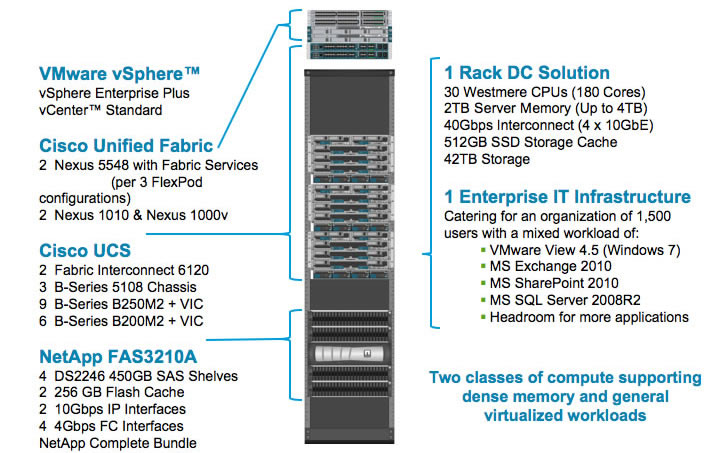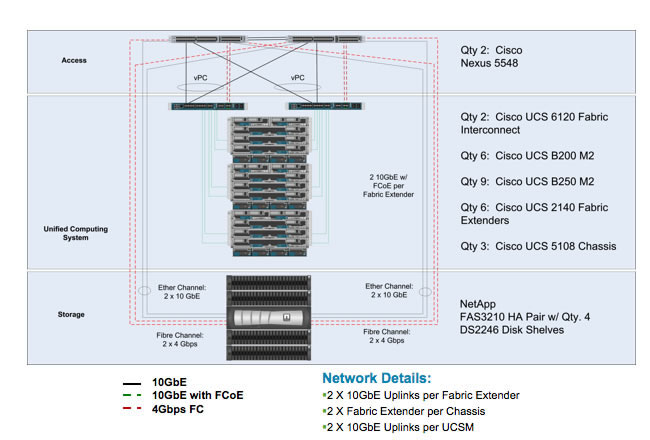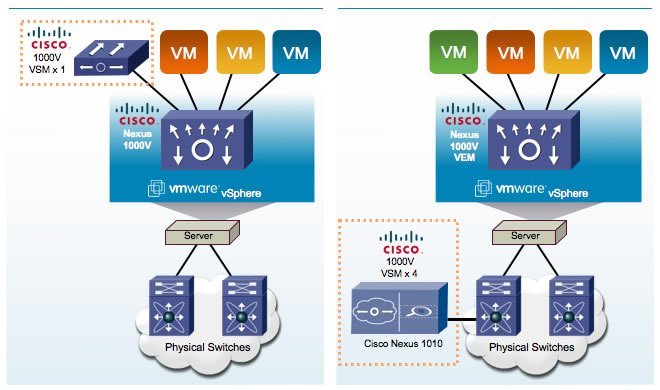Tech ONTAP Articles
- Home
- :
- Tech ONTAP Podcast and Blogs
- :
- Tech ONTAP Articles
- :
- FlexPod for VMware
Tech ONTAP Articles
- Subscribe to RSS Feed
- Mark as New
- Mark as Read
- Subscribe
- Printer Friendly Page
- Report Inappropriate Content
- Mark as New
- Subscribe
- Mute
- Subscribe to RSS Feed
- Permalink
- Report Inappropriate Content
 | |
Shared infrastructure might be the future of IT, but for many of us, the best way to get there remains an open question. The process of integrating heterogeneous server, network, and storage components into a shared infrastructure with balanced performance and high efficiency and then enabling business-critical applications on top of that infrastructure comes with some serious potential pitfalls. Cisco, NetApp, and VMware have created FlexPod™for VMware®—a presized, validated, standardized data center architecture design available through select channel partners—to address these difficulties. FlexPod provides a shared infrastructure built from best-in-class components designed to reduce risk, maximize data center efficiency, and enable you to provision new services or roll out new data center infrastructure quickly and easily. FlexPod is designed with flexibility in mind. You can easily scale up a single FlexPod configuration in any dimension or scale out with multiple identical FlexPod installations. FlexPod sizing and deployment processes are fully documented to further make sure of success. This article describes the components that make up FlexPod for VMware and explores potential workloads. The FlexPod approach to open management is also discussed. What Is FlexPod for VMware?FlexPod for VMware creates a shared infrastructure using leading hardware and software components from Cisco, NetApp, and VMware. The baseline FlexPod configuration is illustrated in Figure 1. All FlexPod components are designed to achieve maximum redundancy and high availability.
Figure 1) FlexPod for VMware components (click to expand). The NetApp FAS3210A storage system used by FlexPod is a dual-controller configuration that includes 42TB of SAS storage and 512GB of Flash Cache for intelligent caching that offers significant acceleration for server and desktop virtualization and other applications. The FAS3210A is able to achieve high levels of storage efficiency using proven NetApp technologies such as RAID-DP®, deduplication, thin provisioning, FlexClone®, and others. On the compute side, FlexPod includes two types of compute blades: the B-Series B200 M2 Blade Server for general workloads and the B250 M2 Extended Memory Blade Server for memory-intensive workloads. The B250M2 offers more than double the memory capacity of a standard two-socket server design to meet the needs of demanding virtualization environments and large dataset applications. Cisco Unified Computing System™ (Cisco® UCS) offers the highest density for virtualization computing, consolidated wiring, and unified fabric for networking simplicity. For networking, Cisco Nexus® 5500 series switches provide a unified, high-speed fabric for connectivity. Figure 2 illustrates FlexPod connectivity in detail and shows that all network paths are redundant.
Figure 2) FlexPod connectivity (click to expand). The networking infrastructure deployed with the first FlexPod configuration provides ports and bandwidth to support up to three FlexPod installations. In other words, you can add two additional FlexPod installations to your infrastructure (for a total of three) before additional networking capacity is needed. Two networking components are specifically designed to support VMware:
Figure 3) Cisco Nexus 1000V and Cisco Nexus 1010 (click to expand). FlexPod for VMware includes VMware vSphere™ Enterprise Plus and VMware vCenter™. VMware is the leading server virtualization technology and includes capabilities such as VMotion™, Storage VMotion, and Distributed Resource Scheduler. For those that already have a VMware Enterprise license, FlexPod is available without the VMware software components. For element management, FlexPod for VMware includes three components:
Many data centers either have standardized on a system management stack or are planning on doing so. To facilitate integration into existing management frameworks, each layer in the FlexPod for VMware solution stack—hypervisor, network, compute, storage—provides open APIs for integration with leading orchestration products from BMC, CA, DynamicOps, HP, IBM, newScale, VMware, and others. FlexPod AdvantagesFlexPod for VMware makes it easy to deploy shared infrastructure. Components are integrated and standardized for fast, repeatable, consistent deployment. FlexPod eliminates much of the guesswork involved in:
You can roll out new applications or grow existing applications quickly and easily.
Security and FlexPodSecurity is obviously critical in shared infrastructure environments. That’s why NetApp, Cisco, and VMware rolled out their first-generation solution for secure multi-tenancy and quality of service almost a year ago. Secure multi-tenancy was recently updated to provide greater security and give you more deployment flexibility. New features include load balancing, SSL offload, and intrusion prevention and detection. The new enhanced SMT architecture is the subject of a companion article in this issue. The architecture used by enhanced SMT is the same as the architecture used by FlexPod for VMware. (The next version of the deployment guide will refer to FlexPod as a starting point.) As a result, you are free to implement the full functionality of the enhanced SMT architecture, or you can choose and deploy just those security features that are needed in your environment. FlexPod WorkloadsWhile single workloads can comfortably be deployed, the FlexPod for VMware design is based on the ability to support 1,500 users running a mixed workload consisting of VMware View 4.5 (VDI), Microsoft® Exchange 2010, Microsoft SharePoint® 2010, and Microsoft SQL Server® 2008R2. In addition, this design leaves sufficient headroom for deployment of additional applications. Initial deployment and sizing documentation is based on these mixed workloads. This is intended as a proof point to demonstrate that FlexPod can satisfy a diverse set of application requirements. Additional sizing validation documents for other applications will be added over time. TR-3884: FlexPod for VMware Solutions Guide gives general guidelines for deploying these and a number of additional applications and solutions on FlexPod:
Getting Started with FlexPodThe presized, validated, and standardized architecture created by FlexPod for VMware offers significant advantages for accelerating the deployment of shared IT infrastructure. FlexPod brings together best-in-class technologies for compute, networking, storage, and virtualization into a preconfigured and easy-to-deploy solution. We’ve made significant efforts to document both the sizing and deployment of the environment to simplify the process of getting started, and we’ve focused on providing open management capabilities that will integrate with whatever tools you currently have in place. A cooperative support model between Cisco, NetApp, and VMware provides a more streamlined response to identify and quickly solve potential issues related to shared infrastructures. This saves you valuable time and resources when requesting support. To learn more about FlexPod for VMware, check out the following documentation: FlexPod for VMware is available through an ecosystem of joint partners that carry the necessary NetApp, Cisco, and VMware certifications and service offerings. This set of partners is listed here.  Got opinions about FlexPod? Got opinions about FlexPod?Ask questions, exchange ideas, and share your thoughts online in NetApp Communities. | Explore A Roadmap for Shared Infrastructure This issue of Tech OnTap features two articles that focus specifically on efforts by NetApp, Cisco, and VMware to simplify and improve your shared infrastructure experience.
Future-Ready Storage Getting your storage infrastructure ready for the future is all about flexibility and efficiency. Last month's issue of Tech OnTap featured articles on three technologies that will put you on the path to shared infrastructure and future-ready IT: |
Please Note:
All content posted on the NetApp Community is publicly searchable and viewable. Participation in the NetApp Community is voluntary.
In accordance with our Code of Conduct and Community Terms of Use, DO NOT post or attach the following:
- Software files (compressed or uncompressed)
- Files that require an End User License Agreement (EULA)
- Confidential information
- Personal data you do not want publicly available
- Another’s personally identifiable information (PII)
- Copyrighted materials without the permission of the copyright owner
Continued non-compliance may result in NetApp Community account restrictions or termination.
In case you haven't seen this already. Interesting take on FlexPod vs VCE. What do you think about it?
http://www.crn.com/news/cloud/229219053/vce-says-vblock-cloud-platform-ready-for-prime-time.htm
----------------------------------------------------------------------------
' VCE partners are also concerned about NetApp's recent campaign of private cloud wins with Cisco and VMware, which have been built on its popular FlexPod architecture for virtualized environments. They're especially perturbed by the notion of VCE founding companies competing with the coalition. '
"Customers are loving the NetApp solution with Cisco UCS and VMware, and they make it easier to get quotes, too. I know I am losing deals because of this," said one VCE partner, who requested anonymity.
weird to see pushback so soon. Flexpod is relatively new. As a cisco ucs/netapp/vmware customer, i have tried to look at flexpod for single support contact and our vendor did not even have flexpod skus available yet for purchase. and this was early just last month






